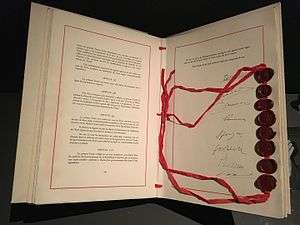Treaty of Paris (1951)
The Treaty of Paris (formally the Treaty establishing the European Coal and Steel Community) was signed on 18 April 1951 between France, West Germany, Italy and the three Benelux countries (Belgium, Luxembourg, and the Netherlands), establishing the European Coal and Steel Community (ECSC), which subsequently became part of the European Union. The treaty came into force on 23 July 1952 and expired on 23 July 2002, exactly fifty years after it came into effect.
Long name:
| |
|---|---|
 | |
| Signed | 18 April 1951 |
| Location | Paris, France |
| Effective | 23 July 1952 |
| Expiration | 23 July 2002 |
| Signatories | "The Six": |
The treaty was seen as producing diplomatic and economic stability in western Europe after the Second World War. Some of the main enemies during the war were now sharing production of coal and steel, the key resources which previously had been central to the war effort.
The Europe Declaration was signed by all the leaders present. It declared that the Treaty had given birth to Europe. It emphasised that the supranational principle was the foundation of the new democratic organisation of Europe. The supranational concept was opposed by Charles de Gaulle.
EU evolution timeline
Since the end of World War II, sovereign European countries have entered into treaties and thereby co-operated and harmonised policies (or pooled sovereignty) in an increasing number of areas, in the so-called European integration project or the construction of Europe (French: la construction européenne). The following timeline outlines the legal inception of the European Union (EU) ― the principal framework for this unification. The EU inherited many of its present responsibilities from, and the membership of the European Communities (EC), which were founded in the 1950s in the spirit of the Schuman Declaration.
| Legend: S: signing F: entry into force T: termination E: expiry de facto supersession Rel. w/ EC/EU framework: de facto inside outside |
[Cont.] | |||||||||||||||
| European Atomic Energy Community (EAEC or Euratom) | [Cont.] | |||||||||||||||
| European Economic Community (EEC) | European Community (EC) | |||||||||||||||
| Schengen Rules | ||||||||||||||||
| [Cont.] | Terrorism, Radicalism, Extremism and Violence Internationally (TREVI) | Justice and Home Affairs (JHA) | European Community (borders, asylum and immigration) and Police and Judicial Co-operation in Criminal Matters (PJCC) | |||||||||||||
Anglo-French alliance |
[Defence org. handed to NATO] | European Political Co-operation (EPC) | Common Foreign and Security Policy (CFSP) | |||||||||||||
| [Tasks handed to EU] | ||||||||||||||||
| [Social, cultural tasks handed to CoE] | [Cont.] | |||||||||||||||
- ¹Although not EU treaties per se, these treaties affected the development of the EU defence arm, a main part of the CFSP. The Franco-British alliance established by the Dunkirk Treaty was de facto superseded by WU. The CFSP pillar was bolstered by some of the security structures that had been established within the remit of the 1955 Modified Brussels Treaty (MBT). The Brussels Treaty was terminated in 2011, consequently dissolving the WEU, as the mutual defence clause that the Lisbon Treaty provided for EU was considered to render the WEU superfluous. The EU thus de facto superseded the WEU.
- ²The treaties of Maastricht and Rome form the EU's legal basis, and are also referred to as the Treaty on European Union (TEU) and the Treaty on the Functioning of the European Union (TFEU), respectively. They are amended by secondary treaties.
- ³The European Communities obtained common institutions and a shared legal personality (i.e. ability to e.g. sign treaties in their own right).
- ⁴Between the EU's founding in 1993 and consolidation in 2009, the union consisted of three pillars, the first of which were the European Communities. The other two pillars consisted of additional areas of cooperation that had been added to the EU's remit.
- ⁵The consolidation meant that the EU inherited the European Communities' legal personality and that the pillar system was abolished, resulting in the EU framework as such covering all policy areas. Executive/legislative power in each area was instead determined by a distribution of competencies between EU institutions and member states. This distribution, as well as treaty provisions for policy areas in which unanimity is required and qualified majority voting is possible, reflects the depth of EU integration as well as the EU's partly supranational and partly intergovernmental nature.
